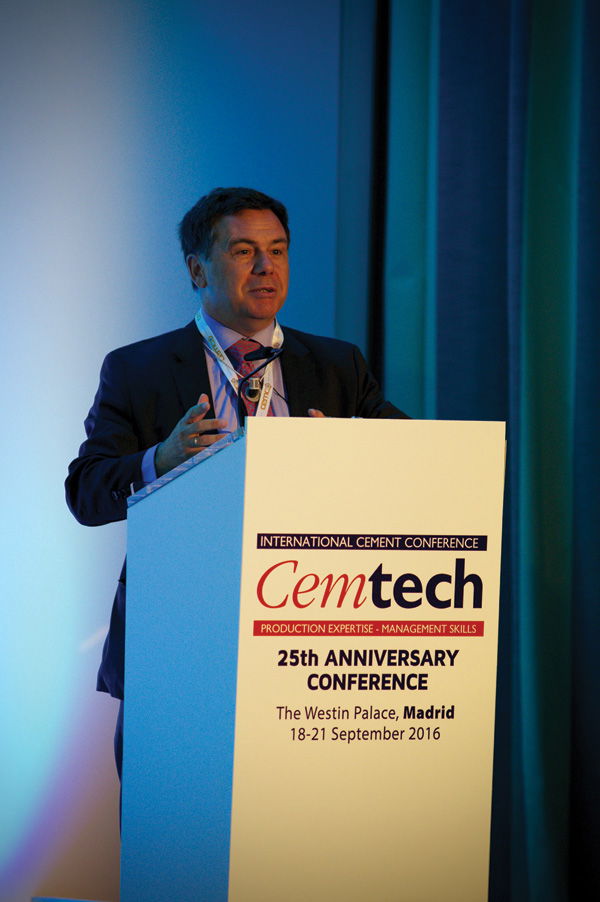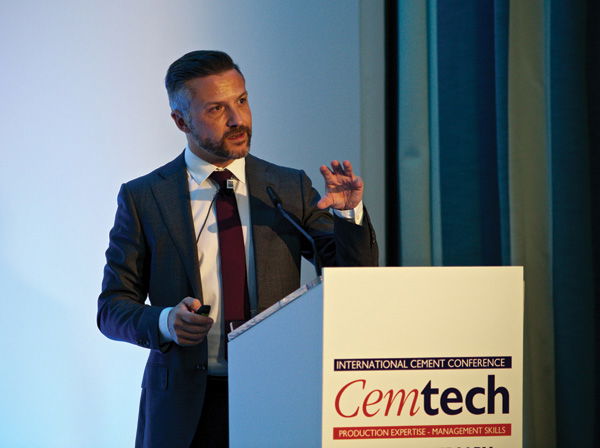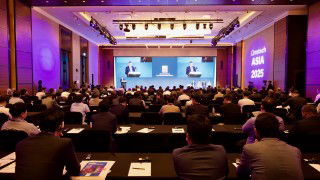Cement professionals from over 40 nations gathered at The Westin Palace, Madrid, to celebrate Cemtech’s 25th Anniversary on 18-21 September. Following major events staged in Dubai and Manila earlier this year, this final celebration marked another successful year of growth for the industry’s leading independent cement conference.

Delegates settle down to the first morning presentations in the conference hall
Cemtech conferences now span the globe, with annual events in Europe, Middle East & Africa, Asia and the Americas. Yet the world into which Cemtech was launched in Prague, back in 1991, is almost unrecognisable to the one we live in now: politically and economically so much has changed and the last decade especially has radically reshaped the cement industry.
Welcoming delegates to Cemtech, Thomas Armstrong, managing editor of International Cement Review (ICR), addressed the last 25 years of change in the cement sector, contrasting the formidable growth of China and Asia with the turn in fortune for Europe, notably since the global financial crisis.
Western Europe’s share of world consumption, which stood at 16 per cent back in 1991, has now fallen to just three per cent, while volumes have contracted by 46 per cent over the same period. These changes have had profound consequences for a number of countries and transformed the international corporate landscape.

Isidoro Miranda, Oficemen and CEO of
LafargeHolcim España
In his opening address to the conference on behalf of the Spanish Cement Association (Oficemen), Isidoro Miranda, CEO of LafargeHolcim España, went on to describe the grave challenges facing the Spanish cement sector, which saw its own construction sector free fall from 2008. Cement consumption has subsequently dropped from 49Mt in 2008 to 11.5Mt in 2015.
“We’re not looking for a future, we’re looking for a present. We’re in a struggle to survive,” explained Mr Miranda. The situation remains challenging with a lack of government investment still insufficient to offset the weakness of the private sector.
Nevertheless, the industry is taking steps to counter the situation. Exports have steadily risen to nearly 10Mta, helping to sustain domestic utilisation rates. Furthermore, according to the next speaker, César Bartolomé Muñoz, R&D manager at the Spanish Institute of Cement and its Applications (IECA), the industry has launched a new initiative to support the cement sector entitled ‘Crecimenta 2030’. The plan provides recommendations for promoting national consumption and hopes to persuade the government to raise infrastructure investment levels and lift cement demand to 30Mt in the long term. Even so, it will still be necessary for the industry to restructure and rationalise the existing production base.
The deep structural changes that Spain is facing as a country are also being reflected in the corporate landscape. Jean-Christophe Lefèvre-Moulenq’s review of the sector’s main European corporates argued that the industry is now in a period of major consolidation and “rebuilding from top to bottom,” as evidenced by the previously-unthinkable merger of Lafarge and Holcim and acquisition of Italcementi by HeidelbergCement. It’s possible, argued Mr Lefèvre-Moulenq, that future deals could involve the creation of medium-sized and agile consolidators to counter the super-giants, with Buzzi Unicem, Titan and Cementir identified as potential consolidators.
Global outlook – signs of growth
In a wide-ranging presentation on global consumption trends, John Fraser-Andrews of HSBC expressed a note of optimism in his analysis that many leading indicators in emerging economies have turned positive in 2016, benefitting from an upturn in the commodity cycle and rising oil prices. In the US the market has experienced a mid-digit increase resulting in a positive pricing environment. In Europe the outlook is also positive, as demand growth looks set to exceed capacity growth in 2017 for the first time since 2013, which will sustain the first meaningful increase in capacity utilisation since 2010.
Extending this coverage, Hina Choksy Evans, ICR’s senior economist, presented ICR’s new global forecast model and how it could be used to forecast consumption in countries experiencing crises, including Britain after Brexit and post-coup Turkey. On a global level, sub-Saharan Africa was identified as one of the key future growth regions going forward.
Addressing climate change

Bernard Mathieu, Head of Sustainable
Development at LafargeHolcim
The keynote presentation at Cemtech was delivered by Bernard Mathieu, head of sustainability at LafargeHolcim and representative of the Cement Sustainability Initiative (CSI). Taking the theme ‘Addressing climate change’ Mr Mathieu argued that reducing carbon emissions remains a key priority for the cement industry, but that efforts will need to be intensified going forward. At the recent Climate Change conference in Paris in 2015 the cement industry committed to new targets to continue reducing CO2 emissions, with the overall objective of carbon neutrality by 2050. For LafargeHolcim this means accelerating the rate at which it reduced CO2/t cementitious product from 0.95 per cent to 1.1 per cent per annum.
Carbon pricing will play a major role and is expected to rise steeply: in France the current government is pushing for a price trajectory starting at €30/t CO2 in 2020 and rising to €100/t CO2 in 2030.
Looking towards new markets
The fall in consumption in Europe has caused regional cement players to look further afield for new areas of growth. A presentation by Francesco Brambilla, HeidelbergCement (Germany), explored the pros and cons of Africa, where high growth potential and elevated prices are balanced against the emerging threat of overcapacity in a challenging business environment.
One company that has committed to Africa in recent years is Limak Group (Turkey), which has commenced cement production in Mozambique and is in the process of setting up a grinding mill in Côte d’Ivoire.
According to Limak’s Business Development Director, Erkam Kocakerim, the group’s activities on the continent are not just about penetrating the cement sector, but vertically integrating into infrastructure investments, including energy and transportation. Mr Kocakerim has high hopes for the sub-Saharan Africa region, believing it will contribute 10 per cent of incremental global cement demand growth until 2030.
Trade and distribution
Given the growing role of Europe as a major exporter of clinker and cement, with significant flows of product moving from countries such as Turkey, Greece and Spain to north and west Africa, the afternoon session focussed on trade and distribution of cement.
Joel Grau, Marmedsa Chartering, spoke about dry-bulk freight rates, which in 1Q16 were at their lowest level ever, so low in fact that they are hardly covering operating expenditures for shipowners. The situation is, however, helping to maintain lower delivered costs for clinker, cement and inputs such as coal and petcoke.
How to achieve a low-cost terminal design was the topic addressed by Javier Martinez, CEO of GlobBulk Consulting (Spain), an independent company specialised in terminal design and construction formed from what was previously Holcim Trading’s projects division. A case study of Cementos Colon in the Dominican Republic illustrated how a cement import operation was progressively upgraded into a bulk cement import terminal (capex: US$1.8m) and then a 0.45Mta clinker grinding station (capex: US$30m).
Karsten Horn of Inform (Germany) concluded the session with a presentation on the role of scheduling software for optimising cement deliveries by rail and road. Such systems can drastically reduce costs as well as provide opportunities for offering premium services to specific customers.
Exhibition
Running throughout the event, the Cemtech Exhibition provided delegates with full access to a range of equipment and service suppliers, while in the evening the exhibition space became the venue for the cocktail reception, offering entertainment and a more relaxed setting for delegates and exhibitors to interact.

Plant tour guests visit Cementos Portland Valderrivas
Production technologies
The second day of the meeting focussed more intensively on technical themes relating to the manufacture of cement. The keynote technical presentation was provided by Andreas Halbleib, head of cement industrial performance, LafargeHolcim (Switzerland), and was a highlight of the conference.
Mr Halbleib provided a fascinating window into the approach taken to merge the technologies of both companies and ensure that the best practices of each were successfully transferred into the unified LafargeHolcim group, which now counts 213 integrated plants and 100 grinding units in its global portfolio.
Mr Halbleib explained how a Synergy Acceleration Task Force was set up to identify the technical strengths of each group, select the best technology at every stage of the manufacturing process and incorporate the findings within one best practice philosophy. One key deliverable was the creation of a new plant-operating model containing a clear vision of how a plant should be run on a day-to-day basis. Another achievement was the creation of a new advanced process control system, merging the Holcim and Lafarge (LUCIE) systems into an entirely new platform.
Other presentations delved further into specific manufacturing categories. Stefan Seeman, head of grinding at KHD Humbolt Wedag (Germany), investigated the advantages of roller press and ball mill combination grinding systems for energy efficient fine grinding of clinker, limestone and slag. Matthias Dietrich, Sika Services AG, Switzerland, argued for the use of grinding aids to enhance the performance of vertical roller mills. Tests have shown a reduction in specific energy consumption (-4.9 per cent) at the same time as an increase in production (+4.5 per cent) along with other benefits including reduced vibration and water consumption. Fernando Dueñas introduced Cemengal’s newest addition to its portfolio of modular grinding mills, ranging in size from the original 25tph concept to the 100tph mill known as the Extreme Plug&Grind.
Miguel Ángel Sanjuán of Spain’s IECA explored how coal bottom ash generated in coal-fired power plants performs in a similar way to coal fly ash and can be used as a new constituent of common Portland cement.
Carsten Wiedmann, ThermoFisher Scientific, provided an overview of X-ray diffraction and application of combined XRF and XRD technologies in the cement industry, while Fabio Chignoli presented Bedeschi’s technology for crushing and handling moist and sticky materials, illustrated with a case study from Slantsy cement plant (Russia).
Dean Tosic of Climeon AB, Sweden, presented a new modular and scalable waste heat power generation system, specifically designed for generating electricity from low temperature gases (70-200˚C) from the preheater and cooler, with a potential application in the European cement sector. A trio of presentations focussed on alternative fuels, including Sharad Thattey, Birla Cement Corp (India), who shared a report on the company’s use of alternative fuels, which include rice husks, municipal waste, saw dust, residual fuel oil and carbon black, along with initiatives by the company to ensure sustainable biomass generation to support a targeted TSR rate of 15 per cent at the plant. Neville Roberts, N+P (UK), described the advantages of co-milling ‘Subcoal’ pellets with bituminous coal or petcoke in a vertical roller mill which is fed direct to the kiln – a convenient solution for producers wishing to burn alternative fuels without capital investment.
Michail Akritopoulos, Cinar (UK), presented alternative fuel case studies illustrating how computational fluid dynamics (CFD) can be successfully applied to kiln and calciner design to create optimal combustion environments of enhanced AF utilisation for solid recovered fuels. Meanwhile, Joel Maia of FCT Combustion showed exactly why CFD can be a powerful tool for solving combustion issues in a calciner that was switching its fuel mix from fuel oil to gas.
Peter Hoddinott (UK), independent consultant and former CEO of Lafarge Africa, presented a thought-provoking and inspiring presentation on the long-term challenges facing the cement industry, where the emerging low-carbon economy and public opinion will force the industry towards a more rapid pace of technological innovation. He highlighted evolving mechanical performance of materials, such as ultra-high performance fibre-reinforced concrete, as important developments which will offer society the opportunity to build stronger structures while reducing CO2.
Plant tour to Morata de Tajuña (Portland Valderrivas)
Delegates visited the integrated cement plant of Morata de Tajuña, located near Madrid. Owned and operated by Cementos Portland Valderrivas, this large integrated plant produces both grey and white cement. The tour showcased the plant’s two 3500tpd grey production lines, alternative fuels facilities and impressive restored quarry. Delegates were also given the rare chance to witness a blasting in an active quarry.
Plant optimisation workshop
Enhancing its reputation as the leading provider of technical information to the sector, Cemtech also included a three-day workshop on cement plant optimisation. Led by Dr Michael Clark, ICR’s technical consultant, this course took participants through the entire production process from raw material preparation to clinker production and finish grinding, exploring techniques for optimising processes and raising efficiency. Participants received a certificate of completion, as well as a complimentary copy of ICR’s ‘Cement Plant Operations Handbook’.
25th Anniversary Gala Dinner

Cemtech concluded with a sumptuous Gala Dinner
Cemtech’s 25th Anniversary year was marked by a sumptuous Gala Dinner in the Ballroom of the iconic Palace Hotel. Fine dining with entertainment from some of Madrid’s leading flamenco groups provided a hugely enjoyable conclusion to Cemtech’s 25th Anniversary year.
Visit Cemtech Conferences on Flickr for the full 25th Anniversary gallery
Article first published in International Cement Review, November 2016.
